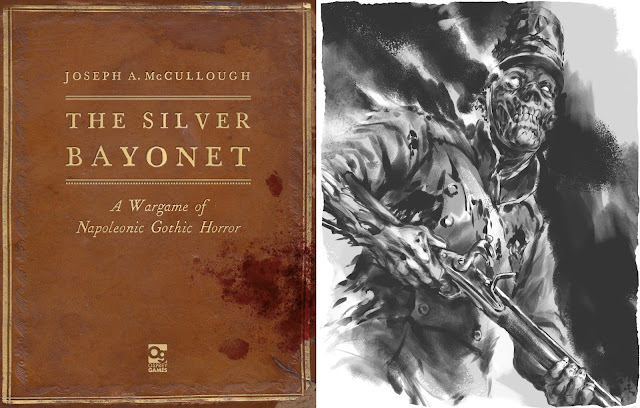First Impressions from Silver Bayonet
We played our first game of Silver Bayonets yesterday. It's a man2man skirmish set during the Napoleonic Wars, with horror/mythology/fantasy elements. I haven't read the rules and I'm not going to buy them, yet, so I'll just add some impressions from a perfectly prepared demo of the game.
The core of the system is fine, the system of two d10 dice where the sum determines hits, and one of results defines damage by weapon type is a really good idea and it makes the game really fast in the evaluation part of the game. On the other side the idea of having extra roll to determine how far you run is really extra in a game of this scale.
The game has hybrid activation, priority player plays with half the models, then monsters go, then the other player goes, and then priority player plays the rest. A player can have a maximum of eight models, so it's not yawn and tea time when it's not my turn.
In summary, the game is built as a variation on Frostgrave, but instead of 1D20 the author adapted the rules to 2d10, but left a lot of old familiar ones in the game. The system is better then Frostgrave, but than, that's almost any game.
 |
| Frontrank Austrians by Paolo Mancini |
But after going through the core system there's not much left to praise. It doesn't really matter if the game is called Silver Bayonet, Silver Broadsword, or Silver Tomahawk, because it's nowhere near Napoleonics, it's an absolutely generic wargame where the author randomly divides up what nation can have what soldiers, but in the end it doesn't really matter for army building. Russians without guards, French without swordsmen is weird, but type of the soldier has none to zero impact on game. The only positive is that at least the Russians don't have a poor shot and the English aren't the best at everything. It seems to me that the decision-making process went something like this: Everyone does medieval, Victorian horror is on sale, Pulp is on sale, so where to set the game? Hey, a lot of gamers have Napoleonics, that's an idea! But the true Napoleonists will burst a vein, and the question is how much attractive is the game to other players, because there are plenty of games of this type available.
Another problem is that soldier stats actually play minimal roles, but larger than in Frostgrave. If you only hit average monster or soldier 36% of rolls and damage is determined by unmodified d10, killing anything realy take time. With average +1 bonus per soldier's ability it's about 45% of the rolls, on the other hand, hitting monsters with defense 15 (the most) and some damage reducing armor is already quite a conundrum since you only hit 21% of the time.
 |
| Village elder (Perry, by Dalcor) vs Goblin (Reaper Bones, by Jiron) |
This makes many scenarios a horror, but for the player. Unfortunately, then the soldiers act as a sacrifice for the monsters to follow up, and with the few remaining human resources you have to try get the objective. Officers aren't heroes, like the wizard in Frostgrave who would have handled the situation. In fact, if you're doing a squad first and then a scenario, even if you have a chance to distribute special items among the squad, functioning as rock-paper-scissors for monsters, many scenarios are pretty hard to play. We had the required items on half of our troops, and we still had to deal with enemies instead of fighting each other because they spammed faster than we could kill them. Plus they spawn right at the clue tokens - that is, the objectives we had to get to. The scenarios are clearly the weakest part of the game and I recommend ignoring them and doing your own narrative.
The last minus I would say is that the game is written to make you buy more manuals. The basic rules are written in a descriptive format to make the book bloat, but it would be enough for a page and a half of dense text. Nations are few, monsters are few, soldiers are few, equipment is few. Compare that to, say, the contents of Burrows and Badgers.
From a slightly different point of view, then, is the problem of figures. Yes there are thousands of Napoleonic figures and people have collections in the tens of thousands. But on multibase, not many people are collecting Napoleonics on single base. There are very few non-marching poses, and even fewer figures that are historically unfaithful, like the officer in a cuirass with a pistol bandoleers, or the investigators. And Northstar's dedicated models are, in my opinion, ugly - in proportion, style, pose and uniforms.
 |
| CSI: Grande Armee (Frontrank, by Jiron) |
On the other hand, the game can work as an unpretentious generic historical man-2-man skirmish for the gunpowder era, where we can add the flavour we want ourselves - the SYW, TYW, GNW, Suvorov in the Alps, Zulu!!!, predators among the Indians. Of course, if we throw out all the mythological serendipity. And perhaps far more interesting is either co-op play or solo play /both modes are part of the rules/, or player with soldiers vs player with baba yaga.
But in conclusion, I have to say that I had a blast with this game. Not so much that it was that great, but thanks to my teammates, the wonderfully prepared Demo team. The game doesn't shine, but doesn't offend either. I'm happy to join in every now and then when it's on. And that's what it's all about in the end, isn't it?
Written by: Dalcor


Komentáře
Okomentovat